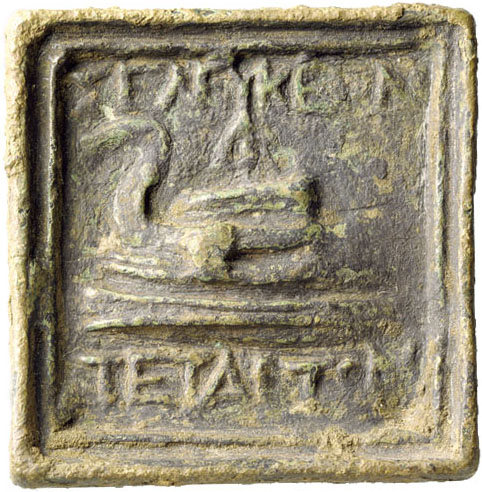
-
Copyright credit: J. Paul Getty Museum

ARCHAEOLOGICAL DESCRIPTION OF THE WEIGHT
Authority
Mint
Seleucia Pieria
Denomination
1/4 Mina
Material
Copper alloy (bronze or brass)
Manufacture
Cast
Shape
Square
Length
7.30 cm
(2.875 inch)
Width
7.14 cm
(2.8125 inch)
Height
0.64 cm
(0.25 inch)
Metrology
| Mass (g) | Mass (grain) | Date of measurement | Reference | fragmented | cleaned | reference weight |
|---|---|---|---|---|---|---|
| 109.81 | 1694.7002 | - | www.getty.edu | No | No | Yes |
Iconography
| Symbol | Technique | Direction | Position | Number | Synecdoche |
|---|---|---|---|---|---|
| Prow | Relief | ||||
| Anchor | Relief | ||||
| Lattice pattern | Relief |
Wear
Corrosion
Handle
No
Suspension hole
No
Recarved mould
No
Recarved weight
No
Intentionally destroyed
No
Archaeological description
True and Hamma 1994: Hellenistic, first half of second century B.C. Bronze; H: 7.3 cm; w: 7.1 cm; Depth: 0.7 cm; Weight: 109.8 g (Tetarton = Quarter Mina of Seleucia Piereiae). Condition: Rather crusty olive green and black patina. The weight is an approximately square plaque. On the obverse a ship’s prow is shown in relief withina molded frame. The vessel is a warship with rams and bow ornament. An unclear trace in the field above may be an anchor. The piece is inscribed ΣΕΛΕΥΚΕΙΟΝ (of the inhabitants of Seleucia) above the ship and ΤΕΤΑΡΤΟΝ (tetarton) below. The reverse is decorated with a precise network pattern. The piece is similar in lettering, square network design, and framing to the other bronze weights from Seleucia in the Fleischman collection (see cat. nos. 94, 95).
Getty Museum: As the port city of Antioch, the capital of the immense Seleucid empire, Seleucia Pieria had a constant flow of trade and commerce. More weights survive from Seleucia Pieria than from Antioch, testifying to the economic importance of this harbor city to the empire. The inscription "Seleukeion" above the ship's prow indicates that this was an official weight of Seleucia Pieria, used as a standard against which other weights could be checked. The lower inscription gives the weight of the piece as a tetarton, a quarter of a mina, the basic unit of weight used in the Seleucid Empire at this time. An unclear trace in the background may be an inverted anchor, a common Seleucid dynastic emblem. Yet, for all the importance of Seleucia Pieria as a port, it is not a merchant ship decorating this weight, but a warship with rams and a bow ornament. Little is known of the Seleucid navy. Treaties with the Romans indicate that Antiochus III, who ruled from 223 to 187 B.C., certainly maintained a substantial fleet in the Mediterranean and his successor Seleukos IV, who ruled from 187 to 175 B.C., used a similar prow of a warship as a symbol on some of his coinage.
Getty Museum: As the port city of Antioch, the capital of the immense Seleucid empire, Seleucia Pieria had a constant flow of trade and commerce. More weights survive from Seleucia Pieria than from Antioch, testifying to the economic importance of this harbor city to the empire. The inscription "Seleukeion" above the ship's prow indicates that this was an official weight of Seleucia Pieria, used as a standard against which other weights could be checked. The lower inscription gives the weight of the piece as a tetarton, a quarter of a mina, the basic unit of weight used in the Seleucid Empire at this time. An unclear trace in the background may be an inverted anchor, a common Seleucid dynastic emblem. Yet, for all the importance of Seleucia Pieria as a port, it is not a merchant ship decorating this weight, but a warship with rams and a bow ornament. Little is known of the Seleucid navy. Treaties with the Romans indicate that Antiochus III, who ruled from 223 to 187 B.C., certainly maintained a substantial fleet in the Mediterranean and his successor Seleukos IV, who ruled from 187 to 175 B.C., used a similar prow of a warship as a symbol on some of his coinage.
Autopsy
No
INSCRIPTION
| Language | Technique | Legend type |
|---|---|---|
| Greek | Relief | Denomination, Mint |
Fac simile
Edition
Σελεύκε[ιο]ν | τέταρτο̣ν̣.
Monogram
ARCHAEOLOGICAL CONTEXT
Findspot (region)
Findspot (site)
context
CIRCUMSTANCES OF ACQUISITION
Region
City
Date of first acquisition
Dec. 31, 1990
circumstances
Gift of Barbara and Lawrence Fleischman (New York, 1925 - New York, 1997) to the J. Paul Getty Museum in 1996. Sold to Barbara and Lawrence Fleischman in 1990, Fritz Bürki & Son (Zurich, Switzerland).
DATING OF THE WEIGHT
Curatorial Section
GREEK
Time frame
FROM
-250
TO
-1
Comments on Chronology
According to Seyrig 1946–48, p. 45–46: 301–187/6 BCE; Getty: First half of 2nd century B.C.
COLLECTION HISTORY
Collection
| Name | Date of acquisition | Inventory number |
|---|---|---|
| Fleischman Collection | Dec. 31, 1990 | F236 |
| Getty Museum – Getty Villa (Malibu) | Dec. 31, 1996 | 96.AC.144 |
Bibliography
| Reference | Page/Column | Reference (number) | Plate / Figure | Comment |
|---|---|---|---|---|
| True and Hamma 1994 | 202–203 | 96 | None | None |
| Getty Museum 1997–98 | 65 | |||
| Tekin 2025a | None | None | fig. 27 | None |
VARIA
Additional comment
Permalink